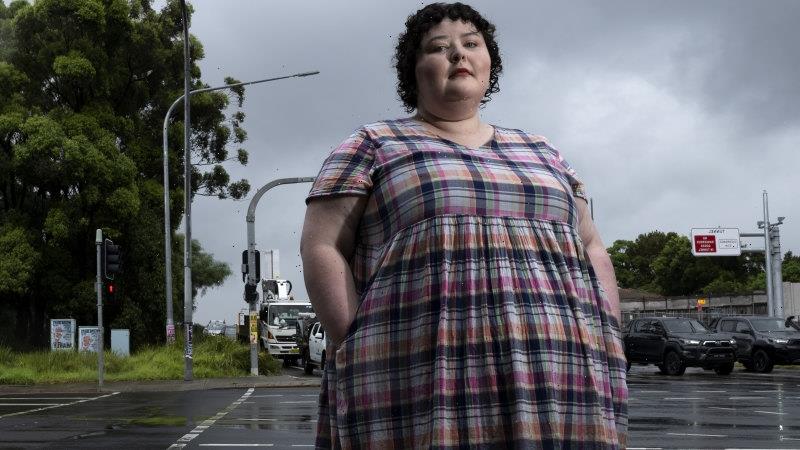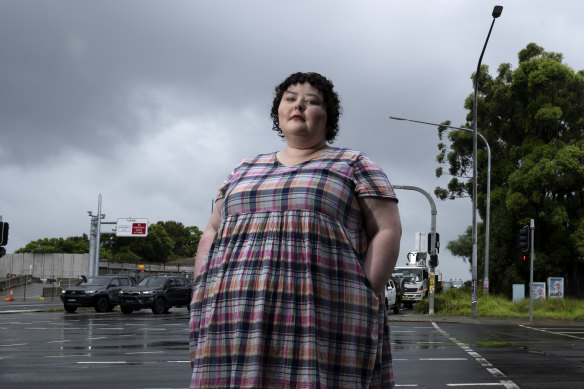More than 600 people are dying prematurely from NSW’s air pollution every year, with wood heater emissions, motor vehicles and power stations among the biggest contributors.
The total health costs based on attributable deaths were about $5.2 billion, a report released by the NSW government the day before it went into caretaker mode this month, shows.
Ebony Wightman’s severe asthma has never been as bad as it is now – when she’s living in an area with high wood heaters and close to Parramatta Road.Credit:Louise Kennerley
The report measures fine particles, known as PM2.5, which refers to their diameter of 2.5 micrometres or less, and found they were higher in densely populated areas of Sydney, Newcastle, Wollongong, and the Upper Hunter region.
These particles are so small they can penetrate the lungs and bloodstream. Long exposure to the particles can cause poor health outcomes, including strokes or heart attacks.
The report notes that each year the number of premature deaths from wood heaters is about 269, industry, including power generation from coal and gas, contributed to 133 deaths, while vehicles contributed to 81 deaths. In total, the report estimates 603 premature deaths are attributed to human-induced PM2.5.
The estimated cost of these deaths was $2.2 billion, $1.1 billion and $674 million respectively.
The data is based on 2013 air emissions, but air pollution sources have remained fairly constant during the past decade. The next report will be due in 2024, with data collected in 2018.
Nature Conservation Council policy director Dr Brad Smith said the report highlighted the need to electrify homes and cars, and move away from coal mining and burning.
“It’s a silent epidemic and hundreds are dying every year in the Sydney region alone,” he said. “Coal mines and coal-fired power stations are given free passes to pollute, and people are bearing the cost.
“If governments needed another reason to leave coal, gas and oil in the ground, and wood in forests, here’s 5 billion reasons.”
‘Coal mines and coal-fired power stations are given free passes to pollute, and people are bearing the cost.’
Inner west resident Ebony Wightman has had severe asthma since birth but said since living beside Parramatta Road and the smoke stacks near WestConnex, it’s the worst it’s ever been. Even smoke from neighbouring fireplaces is enough to affect her.
There have been times when Wightman can hardly walk. She’s been in and out of hospital and receives fortnightly injections just to make her asthma manageable.
“It has been really tough,” she said. “I’ve almost died a few times. Every time I go into the hospital, I am in the resuscitation bay.”
Wightman and her partner have considered moving to regional Australia where the air quality would be better, but they have concerns there would be limited medical support for Wightman’s asthma.
“I wish I could have the best of both worlds [medical access and clean air],” she said. “I would be dead if I didn’t have RPA down the road.
“If the government and people in my community took air health more seriously, my life and other people’s lives could be different and we could have a better quality of life. When I have to stay at home with an air purifier, it is not much of a life.”
Asthma Australia chief executive officer Michele Goldman said the number of air pollution deaths across Australia is thousands of people per year. She said it was only during major events, such as the 2019-20 bushfires, that people became acutely aware of air pollution.
“It is not just at high concentrations of different pollutants that our health is impacted. Even low levels of pollution if we are exposed on a cumulative basis impacts on our health, and the community deserves to make informed choices,” Goldman said.
Get to the heart of what’s happening with climate change and the environment. Our fortnightly Environment newsletter brings you the news, the issues and the solutions. Sign up here.
Most Viewed in Environment
From our partners
Source: Read Full Article




